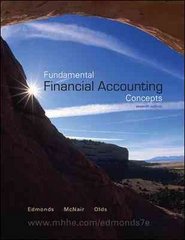Answered step by step
Verified Expert Solution
Question
1 Approved Answer
1. a. Distinguish between microeconomics and macroeconomics. (2 marks) b. Label each of the following news headlines as a microeconomic or macroeconomic topic. (8 marks)
1. a. Distinguish between microeconomics and macroeconomics. (2 marks) b. Label each of the following news headlines as a microeconomic or macroeconomic topic. (8 marks) (i) Edmonton woman wins over $21 million in lottery (ii) Oil closes above $120 a barrel for the first time (iii) Bank of Canada raises interest rates (iv) Dropout problem at high school 2. On a graph of the circular flow, label the flows in which the following occur. (10 marks) a. wages paid by firms b. dividends paid by businesses c. capital owned by households and used by firms d. land rented to businesses e. cars sold by firms to households 3. Identify the following as consumption or investment goods or both. Justify your answers. (10 marks) a. an iPod b. a share of stock c. the Trans-Canada highway d. a ski lift e. an unsold truck by a GM plant in Ontario 4. Base your answers to the questions on this information: In one month, Jason can produce either 300 kilogram of foods or 150 litres of liquor. (10 marks) a. If Jason produces 250 kilograms of food per month, how much liquor must he produce to achieve production efficiency? b. Calculate the opportunity cost of producing 1 kilogram of food, Show your work. c. Calculate the opportunity cost of producing 1 litre of liquor. Show your work. d. What is the relationship between your answers to b and c? e. What is the marginal cost of a litre of liquor when the quantity produced is 75 litres a month? What is special about Jasons marginal cost of liquor? 5. Explain how each of the following events will influence the demand or supply of oil, and predict the change in equilibrium price and equilibrium quantity. (10 marks) a. New technology greatly improves the extraction of oil from tar sands. b. Large sport utility vehicles become unfashionable, and are replaced by hybrid vehicles and greater use of public transit. c. Income of consumers decline. d. Canada and US start producing fuel efficient automobiles. e. Conventional oil sources are depleted with no new significant discoveries to replace them. 6. The table below sets out some data for Country X in 2007. (10 marks) Item Amount (in billions of dollars) Consumption expenditure 289 Government expenditure 99 Interest and investment income 33 Profit of corporations and government enterprises 65 Income from farms and unincorporated businesses 40 Gross investment 146 Exports 36 Imports 22 Wages, salaries, and supplementary labour income 275 Capital consumption allowance 60 Indirect taxes less subsidies 75 a. Calculate net exports. b. Use the expenditure approach to calculate GDP. c. Use the income approach to calculate GDP. d. Calculate net domestic product (at factor cost). e. Calculate net domestic income (at market price). 7. If the nominal GDP is $559 billion in the base year, and it rises to 577 in year 1, and 605 in year 2, what is the real GDP in each year, given that the price index has risen from 100 in the base year to 104.5 in Year 1 and up to 108.3 in Year 2? If the price index 20 years before the base year was 41.2, and the nominal GDP for 20 years before the base year was 191.0, what was the real GDP for that year? Show your work in all cases. (10 marks) 8. In many Sub-Saharan African countries, girls have lower enrollment rates in secondary schools than do boys. If government policy can provide good schools and encourage girls to take advantage of them, (10 marks) a. describe two ways in which greater education opportunities for girls could lead to faster economic growth. b. explain what will happen to potential GDP. c. explain what will happen to employment. d. explain what will happen to real wage rate 9. In 2008, the debt of Canadian households rose much faster than their wealth as stock markets corrected and the housing market slowed down. During the first quarter of the year, overall household debt rose by about 3 percent, while personal disposable income rose by 2 percent (Financial Post Magazine, August 19, 2008). (10 marks) a. Explain why the growth of household wealth slowed in Canada. b. When a household buys shares (stocks), does that represent consumption, saving, or investment? Explain. c. When a household buys a new house, does that represent consumption, saving, or investment? Explain. d. What factors may influence a household when deciding between buying stocks, bonds, or a house? 10. Which of the following would or would not be included in the calculation of GDP? Justify your answer in each case. (10 marks) a. an initial public offering (IPO) for Wind Mobile in Ontario b. the sale of previously owned antique cars in Edmonton, Alberta c. the purchase of new helicopters for Canadian military d. the coverage of prescription eyewear under Alberta Blue Cross e. the diner at Red Lobster Restaurant in Edmonton
Step by Step Solution
There are 3 Steps involved in it
Step: 1

Get Instant Access to Expert-Tailored Solutions
See step-by-step solutions with expert insights and AI powered tools for academic success
Step: 2

Step: 3

Ace Your Homework with AI
Get the answers you need in no time with our AI-driven, step-by-step assistance
Get Started


